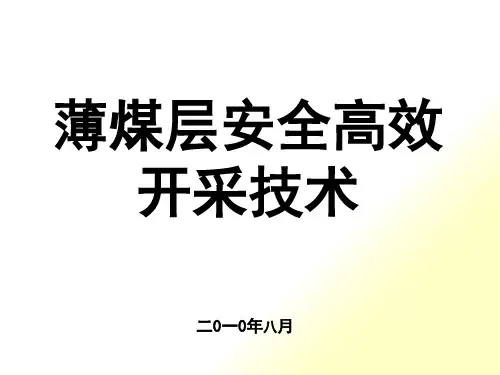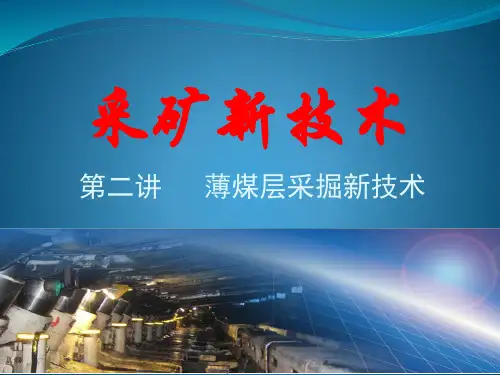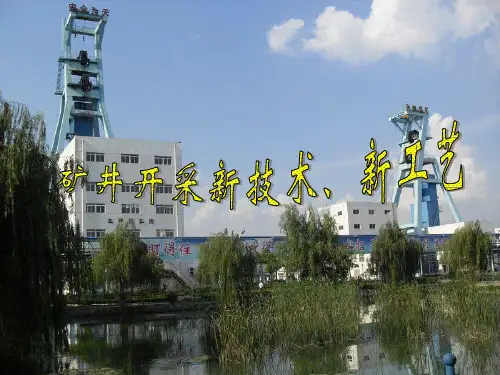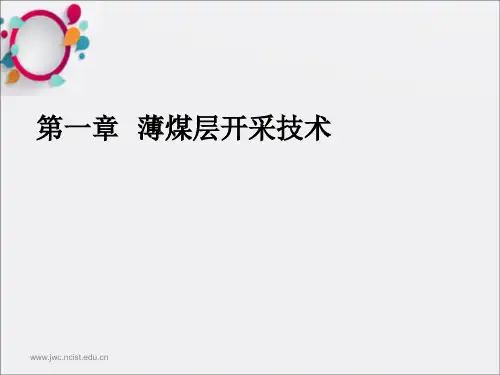《薄煤层开采新技术》PPT课件
- 格式:ppt
- 大小:3.84 MB
- 文档页数:118

UBB Report: A Failure of Basic Coal Mine Safety Practiceshe report to the Governor by the Governor’s Independent Investigation Panel led by J.Davitt McAteer on the Upper BigBranch explosion is subtitled A Failure of Basic Coal Mine S afetyPractices . This investigation, one of several, is thorough, but not entirely exhaustive because there are still questions which remain, in part,because of the force of the explosion destroyed much of the evidence. Twenty-nine miners died and one was seriously injured as the enor-mously powerful blast rocketed through two and one-half miles of underground workings nearly 1,000feet beneath the surface of the rugged mountains along the Coal River. The disaster has grave conse-quences for a mining company, for a community, and, most importantly,for the family members who lost men dear to them.The blast was actually a series of explosions created as the com-pressed air on the leading edge of the force caused the coal dust to become airborne. In this way, the explosion generated its own fuel with the air and dust mixture behav-ing like a line of gunpowder carrying the blast forward in multiple direc-tions toward the outside of the mine,deeper into the tailgate and along the longwall face toward Headgate 22, Tailgate 22, and 9 North.The line of explosion raced out of the Tailgate and through Crossover 21. While the main force was con-centrated in the track entry, it also spread through the crosscuts to the left and right as it encountered fresh coal dust. Once it crossed the con-nector, it traveled down the longwall headgate to North, up the 6 North belt entry and 7 North belt and onto Headgate 22, where it reached its strongest levels. When the force reached the end of the entry onHeadgate 22, it reversed course and raced back out, obliterating every-thing in its path.In the chapter entitled Events Leading up to the Explosion , the low volume of air in the mine was described by several witnesses. The subject of questionable anemome-ter readings taken underground is documented. There were problems with significant water accumula-tions. Accurate air readings and water levels in those key ventilation entries would provide a valuable his-tory of conditions in a critical part of the mine in the days and weeks prior to the explosion.There was some confusion in the Command Center after the explo-sion to which an entire chapter of the report is given. In the Command Center at UBB, the report says that “many things did not work well.” For example, notetaking was spotty and as a result, Command Center offi-cials failed to create an adequate written record to indicate how events transpired. Interviews with officials indicated that the phone calls to the Command Center from underground either were not recorded or were recorded munication from the media and families of the missing miners fil-tered into the Command Center and decisions were influenced by these events. The suggestion was made to use a digital recorder for phone calls which had been used during emer-gency response drills, but this sug-gestion was rejected. S ome mine rescue protocols were not carried out.A whole chapter is devoted to coal dust and rock dust. The senior mem-ber of the two-man dust crew indi-cated that on nights when he was not pulled off his dusting duties to do other jobs, he drove a motor that pulled or pushed a big orange trackduster with two pods that held about a ton and a half of rock dust. Mines the size of UBB typically use track-mounted tank or pod dusters about the size of this one. From the effi-cient use of track duster at a mine the size of UBB would have required drilling a borehole midway in the mine and not far from the working sections to allow a speedy delivery of bulk rock dust to refill the tank dusters. There was no such borehole at UBB. The age and poorly main-tained conditions of the dusting equipment, coupled with the fact that UBB did not have an estab-lished rock dust crew that adhered to a schedule like that of a produc-tion crew, indicated that rock dust-ing was not a priority at Upper Big Branch in the early days of 2010.This was illustrated by the fact that between March-April pre-shift reports indicated that of the 561rock dustings requested, only 65dustings were subsequently noted,or 11.6 percent of the time it was requested. Tests conducted by MS HA after the disaster support miners testimony that the UBB mine was poorly dusted. An analysis of 1,803 dust samples taken after the explosion, MS HA found that 78.92percent were out of compliance withthe federal standard.Small methane ignitions did not have to turn into a major explosion if the mine operators adhered to basic safety measures, such as maintain-ing adequate ventilation systems,removing explosive coal dust from mining operations, spreading required amounts of rock dust, and ensuring that water sprays on mining equipment are kept in good repair and function properly. The forensic soot and dust sampling that took place at UBB indicated there simply was not enough rock dust applied.One of the surviving miners,S tanley S tewart, who had been heading underground at the time of the explosion, said as he emerged from the mine he could see air “still whooshing out…it was still strong.”S tewart estimated that the wind blew for at least two minutes. The footprint left behind in the Upper Big Branch mine and the testimony of survivors supports the theory that the explosion started with methane and fed on coal dust as it tore through the mine. The report says that both evidence in the mine and testimonial evidence suggest that Massey Energy’s management failed to properly ventilate UBB because they did not have adequate resources, knowledge, and/or capa-bility to develop a sound, workable ventilation plan to address the par-ticular circumstances of UBB. The ventilation system for a mine with a history of methane infusions, such as those experienced at Upper Big Branch, must be capable of remov-ing even a large gas inundation. The troubled ventilation system at UBB was incapable of providing suffi-cient air to sections and to the long-wall, and certainly was not robust enough to handle a massive influx of natural gas or methane.In addition, the company did notplace enough emphasis on rock dusting and maintenance of equip-ment, even full compliance with fed-eral and state rock dusting stan-dards may not have prevented the initial ignition on the tail of the long-wall. However, a well-dusted mine would have put the brakes on a propagating explosion and the death toll would have been signifi-cantly less.Furthermore, investigators exam-ining the shearer on the head and tail drums found numerous missing plugs and poorly maintained water sprays. These sprays, when working properly, are vital to safe longwall operation. Effective water sprays create a mist that extinguish sparks generated when the cutting bits on the shearer strike rock adjacent to the coal seam; dilute or douse methane ignitions created when sparks come in contact with explo-sive methane gas; knock down dust generated by the shearers cutting action; and keep parts of the long-wall machinery cool as it cuts through coal and rock. Of the 23sprays on the head drum visible to investigators, nine were plugged; of the 30 sprays on the Tail Drum visi-ble to investigators, seven were totally missing. S ome other sprays were found to have been rendered ineffective because, in an effort to unclog them, the nozzle openings had been widened. When investiga-tors tested the water sprays on the longwall, there was not enough water pressure on the tail drum to even produce a reading.UBB pumped water into the mine from the nearby Coal River and from the underground wells nearby.Modest efforts were made to design a new filter to screen out sediment,but like other maintenance tasks,the filters were neglected, and testi-mony with physical evidence indicat-TUBB ReportShearer Tailgate Cutting Drum Sandstone Top and Floor Heavinged that the screen and sock filters were frequently plugged so much that the sprays were clogged. If all the water sprays had been properly maintained and functioning, and if rock dust had been properly applied, any ignition of methane that occurred would likely have been extinguished at its source, says the report.An interesting chapter in thereport entitled The Massey Way describes the culture at Massey Energy. This chapter concludes,“This history of inadequate commit-ment to safety coupled with a win-dow dressing safety program and a practice of spinning information to Massey’s advantage works against the public statement put forth by the company that the April 5, 2010explosion was a tragedy that couldnot have been anticipated or pre-vented.”The report concludes that “ulti-mately, the responsibility for the explosion at the Upper Big Branch mine lies with the management of Massey Energy. The company broke faith with its workers by frequently and knowingly violating the law and blatantly disregarding mine safety practices while creating a publicperception. This operation unheed-ed industry safety standards. The story of Upper Big Branch is a cau-tionary tale of hubris. A company that was a towering presence in the Appalachian coalfields operated its mines in a profoundly reckless man-ner, and 29 coal miners paid with their lives for the corporate risk-tak-ing. The April 5, 2010 explosion was not something that happened out ofthe blue, an event that could not have been anticipated or prevented.It was, to the contrary, a completely predictable result for a company that ignored basic safety standards and put too much faith in its own mythology.”Editor’s Note:The photographs below were taken at UBB but are not part of this report.The Role of MSHA at UBBhe role of MSHA is not over-looked and a chapter is devot-ed to this. According to the report, “despite MSHA’s consider-able authority and resources, its col-lective knowledge and experience,the disaster at the Upper Big Branch mine is proof positive that the agency failed in its duty as the watch dog for coal miners.”The report draws attention to the fact that high-ranking MSHA offi-cials apparently were aware that the agency was falling short in its responsibilities. On March 25,2010, less than two weeks beforethe disaster, MSHA Chief Joe Main submitted a required report to the U.S. Senate Appropriations Committee, which outlined wide-spread lapses in enforcement. An audit of 25 field offices during 2009conducted by MSHA’s Accountability Office found incom-plete inspections, failure to monitor mines liberating high amounts of methane, and inadequate supervi-sory actions. Auditors found that in 21 of the 25 field offices, supervi-sors failed to conduct in-depth reviews to make sure enforcement levels and actions were in accor-dance with the agency’s policies and procedures. In 20 field offices, the auditors found inadequate evalua-tion of the gravity and negligence of the health and safety violations issued against operators. In 15offices, auditors found that inspec-tors failed to adequately document findings so that enforcement actions would be able to withstand legal challenges.The Upper Big Branch mine was a gassy mine, liberating about 1 mil-lion cubic feet of methane per 24-hour period, and as a result was sub-ject to federal spot inspections.More significantly, the UBB mine had experienced at least three major methane-related events. The first occurred in January 1997, another in July 2003, and a third in February 2004. All took place in longwall mining sections. Witnesses, too,and investigators of the 1997 inci-dent included a number of individu-als who remain employed by MSHA,the West Virginia Office of Miners’Health Safety and Training, and Massey Energy. MSHA technical experts who investigated the 2003and 2003 outbursts indeed did rec-ommend special precautions, but officials at MSHA’s Mt. Hope District Office did not compel UBB manage-ment to implement those recom-mendations.The Governor’s Independent Investigation Panel found four fail-ures of MSHA. One, disregarding the documented risk of methane out-bursts at UBB. Two, overlooking the deadly potential of a precarious ven-tilation system. Three, neglecting to use its regulatory authority to force technological improvements to advance miners safety. Four, allow-ing the U.S. mine safety system to deteriorate.TThe State Responsibility at UBBhe West Virginia Office of Miners Health Safety and Training (WV OMHST) was also criticized in the report. Records indi-cate that, even with the limited staffing and resources, state mine inspectors spent a considerable amount of time at UBB. Inspectors were on site for at least 70 days in 2009 and for another 15 days in the three months preceding the April 5,2010 explosion. They wrote more than 330 violations and assessed $154,600 in penalties.One of the state inspectors with 16years of experience with the agency,and 35 years in the mining industry,had some strong opinions as to how the state might have been able to do a better job at UBB, says the report.“A couple of guys should be assigned to that mine,” he said. “It’s a very expensive mine, very large mine, just to be able to go in all directions at one time, every couple or three weeks or something. That’s my opinion.” The inspector was referring to the physi-cal area that had to be examined,rather than the coal production. He admitted that quarterly inspections were not always completed and appeared to have limited knowledge about UBB’s ventilation system. He also did not appear to have a great knowledge about MSHA’s action with regard to ventilation at UBB.The state official does not have dedicated ventilation specialist inspectors, and as the result, instead of offering an independent layer ofsafety for miners, West Virginia, like most other states, relies on MSHA to flag ventilation problems in mines,usually following the federal lead as to whether ventilation systems meet code.As for rock dusting, the state inspector said he did not write many cleaning and dusting violations, but during his last quarterly inspection,he wrote violations for cleaning and dusting on Four and Five Ellis belts,Four North Belts head areas, areas from the longwall switch to Headgate 22, and the Headgate 22 section belt.After the explosion, based on extensive tests, investigators deter-mined that inadequate rock dusting was a significant contributing factorto the size and intensity of the explo-sion. Unfortunately, the WV OMHST failed to recognize that the mine was not adequately rock dusted, in part,because inspectors relied on visual inspections. Perhaps inspectors rec-ognized the need for rock dusting, but did not grasp the severity of the prob-lem at UBB. More likely, the officials did not connect the dots so as to see the complete picture and recognize the overall heightened danger pre-sented by each independent viola-tion. The report concluded that state mine inspectors failed to recognize faulty ventilation and inadequate rock dusting because they lack suffi-cient training to develop specialized expertise in ventilation, because they do not have an adequate inspectionforce and because they rely on visual inspections rather than scientific testing to determine whether rock dusting is complaint with state law.The report says there are within the WV OMHST many dedicated, commit-ted, and safety conscientious inspec-tors and supervisors who are not afraid to issue citations or provide tough enforcement. However, the overwhelming scope of the job, the economic circumstances of a boom-ing coal industry, the pressure to get along, the recognition of the impor-tance of mining jobs within the state are factors that place immense pres-sures on state inspectors, pressures which make the regulatory enforce-ment process difficult to carry out.TExplosion Force Bent Roofbolt Plate and Shows DirectionExplosion Underground Bent the TrackUBB Report: Findings and Recommendationhe report has 11 findings including the following:• The disaster at UBB was man-made and could have been prevent-ed;• The mine explosion occurred because of failures of three basic safety practices with regard to venti-lation, rock dusting standards, prop-er maintenance of safety features on mine machinery;• Twenty-first century coal mine safety practices have failed to keep up with twenty-first century produc-tion practices;• The pre-shift/on-shift exanima-tion system has in many instances become a meaningless exercise;• MSHA and WV OMHST inspectors and their supervisors must craft enforcement strategies which match the compliance approach of the mining company;• Federal and state mine safety laws allow mine operators to use administrative or judicial review to avoid or delay paying citations and penalties;• The emergency response at U BB raised concerns about how decision-making was conducted in the Command Center and the manner in which mine rescue teams were deployed;• Investigations of major mining disasters must be conducted in an open, independent, and transparent manner;• SCSR training BB miners received was not effective;• The prevalence of coal workers’pneumoconiosis among the deceased U BB miners is both sur-prising and troubling.The report also contains 52 rec-ommendations and among them are the following:• Each mine should be required to maintain and continuously update records of the amount of rock dust purchased and used daily;• WV OMHST and MSHA should undertake reorganization on their ventilation approval system;• “Black box” technology must be instituted for mining equipment,including shearers, continuous min-ers, roof bolters, shuttle cars,motors, conveyors, and shields,proving information regardingmethane, oxygen, carbon monoxide,and coal dust levels;• There must immediate implemen-tation of a computerized, real-time electronic personnel recording sys-tem to formerly identify and locate all personnel underground;• Each mine must be required to institute a “Communication and Information Recording Center” to provide instantaneous communica-tion to MSHA state agencies, com-pany officials, and state and county emergency management officials regarding safety and health;• Current monitors for methane,carbon monoxide, and coal dust must be upgraded to include memo-ry chips;• Operators must be required to use real-time continuous monitoring for explosive methane gas and res-pirable dust;• Mechanized rock dusting must be conducted in all portions of under-ground mines;• Operators must assess the ade-quacy of rock dust through direct readout explosibility meters;• The system for writing violationsshould be converted from paper and pencil to a computerized system and digital photographs should be used;• Regulatory agencies should use ventilation simulation models as part of their plan approval process;• MSHA and NIOSH should develop an approved rescue vehicle;• Federal and state agencies should undertake an aggressive campaign to undermine the “safety myths” or inaccuracies that emerged during the U BB investiga-tion;• Existing laws and regulations must be stringently and effectively enforced;• When either state or federal agen-cies recognize a significant or per-sistent problem at a mine,the agency should coordinate their responses;• The mining industry, MSHA, and West Virginia should adopt the National Incident Management System (NIMS) Incident Command Model to improve coordination;• Protocols should be established and followed with regard to mine rescue and recovery;• MSHA and West Virginia should require digital recording of the activ-ities and communications in a mine emergency Command Center;• WV OMHST, NIOSH, MSHA, and the mining industry should adopt before the end of 2011 rules to reduce the permissible exposure limit (PEL) for coal mine dust to 0.09mg/m3 and reduce the PEL for crys-talline silica to 0.05 mg/m3; and mandate continuous dust monitor-ing.It should be noted that 17 individ-uals invoked the Fifth Amendment right and declined to be interviewed by investigators examining the explosion at UBB. The Fifth Amendment of the Constitution of the United States provides an indi-vidual from self-incrimination. Self-incrimination includes act or decla-rations either as testimony at trial or prior to trial by which one implicates himself in a crime. The Fifth Amendment prohibits the govern-ment from requiring a person to be a witness against himself involuntarily or to furnish evidence against him-self.TForensic soot and dust sampling has indicated that soot and coke created by the explosion and burning of coal dust shows the le vels of burn, low to high.There are sections where no burn is indicated where one would expect the explosion and burn to have taken place, ie.., across the # 7 North connector. When the explosion reaches extremely high speeds, a phenomenon occurs where there is no burn because the explosion is traveling too fast to create a burn. At UBB, 1,803 samples were collected by teams of at least 30 individuals. A large number of samples showed high flame and coke. Th e report says that there was simply not enough rock dust applied at UBB.。








